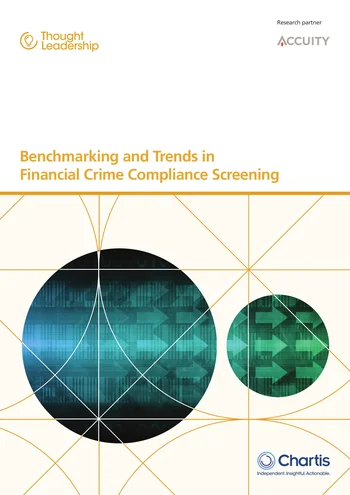FIs face growing fines for failings in their compliance processes, while the technology to support screening systems continues to evolve rapidly. Against this background, FIs must approach financial crime compliance screening with a clear strategy informed by the state of regulation and technology. In light of this, this report explores the current state of financial crime compliance screening and the market for screening solutions.
The survey
This report presents the findings of a joint global survey on the financial crime compliance screening technology market conducted in Spring 2019 by Chartis Research and Accuity. Of 131 total respondents, 109 (83%) were from financial services firms. Of these:
- 44% were headquartered in Europe1.
- 18% were headquartered in North America.
- 14% were headquartered in the Asia-Pacific region.
- 24% were headquartered in the Rest of the World.
In addition:
- 27% of FI respondents were from Tier 1 organizations.
- 21% were from Tier 2 organizations.
- 52% were from Tier 3 organizations.
For more detail on the region and tier specifications see Appendix B.
The report
After this introduction, our report is divided into four sections.
- The first explores and assesses the key trends in financial crime compliance screening highlighted by our survey2. We examine FIs’ current approaches to financial crime compliance screening, considering a shift in emphasis from screening speed toward screening accuracy, and the growing popularity of ‘component-based’ technology strategies. We also consider what these and other trends mean for the future of FIs’ financial crime compliance screening approaches.
- The second section (Appendix A) provides quantitative survey results addressing key elements of the financial crime compliance screening process, such as:
- The volumes of accounts and transactions screened.
- The numbers of full-time employees dedicated to screening activity by different respondents.
- The volume of positively flagged entities our respondents are reporting.
Readers can use these results to benchmark themselves against the screening processes of peer institutions.
- The third section (Appendix B) provides key benchmark figures by tier and region.
- The fourth section (Appendix C) provides definitions of our regional and institution-size survey categories.
1 For definitions of the categories used in the survey, see Appendix C.
2 Note that rounding factors mean that some charts may not add to exactly 100%.
Only users who have a paid subscription or are part of a corporate subscription are able to print or copy content.
To access these options, along with all other subscription benefits, please contact info@risk.net or view our subscription options here: http://subscriptions.risk.net/subscribe
You are currently unable to print this content. Please contact info@chartis-research.com to find out more.
You are currently unable to copy this content. Please contact info@chartis-research.com to find out more.
Copyright Infopro Digital Limited. All rights reserved.
As outlined in our terms and conditions, https://www.infopro-digital.com/terms-and-conditions/subscriptions/ (point 2.4), printing is limited to a single copy.
If you would like to purchase additional rights please email info@chartis-research.com
Copyright Infopro Digital Limited. All rights reserved.
You may share this content using our article tools. As outlined in our terms and conditions, https://www.infopro-digital.com/terms-and-conditions/subscriptions/ (clause 2.4), an Authorised User may only make one copy of the materials for their own personal use. You must also comply with the restrictions in clause 2.5.
If you would like to purchase additional rights please email info@chartis-research.com






